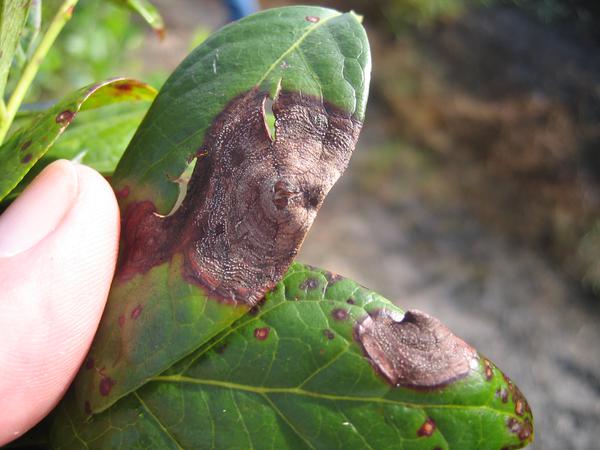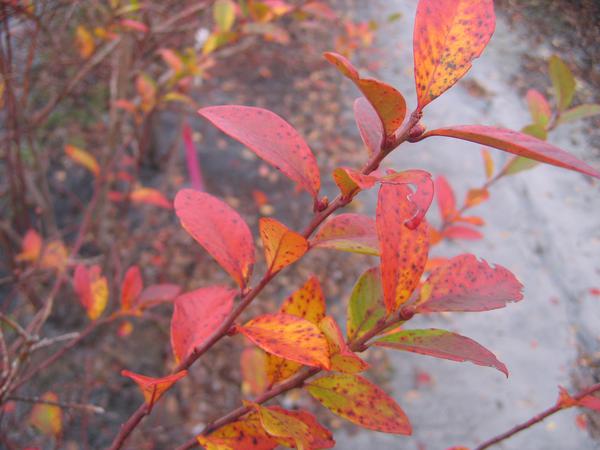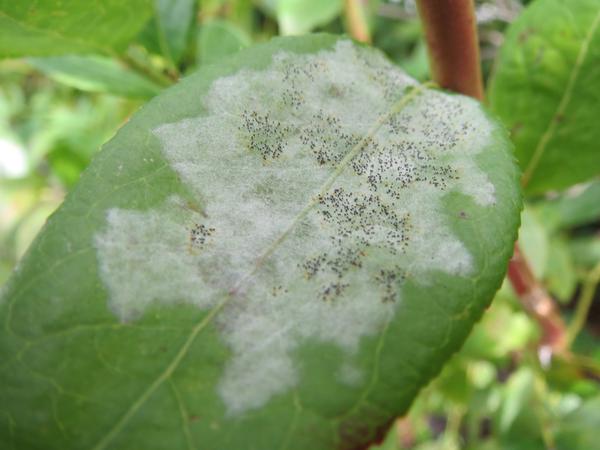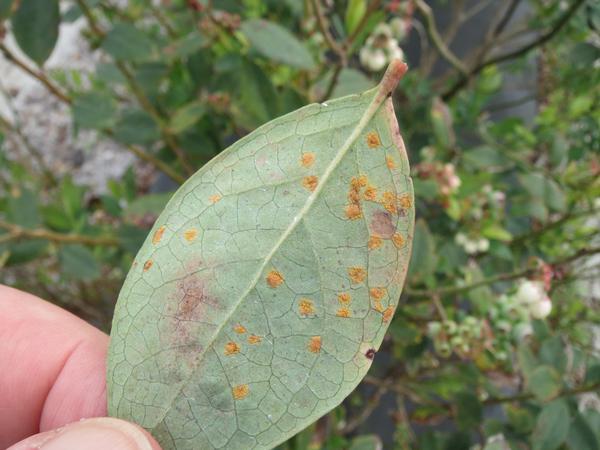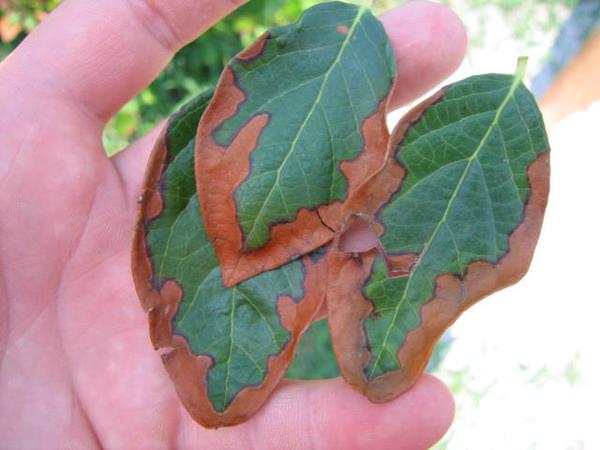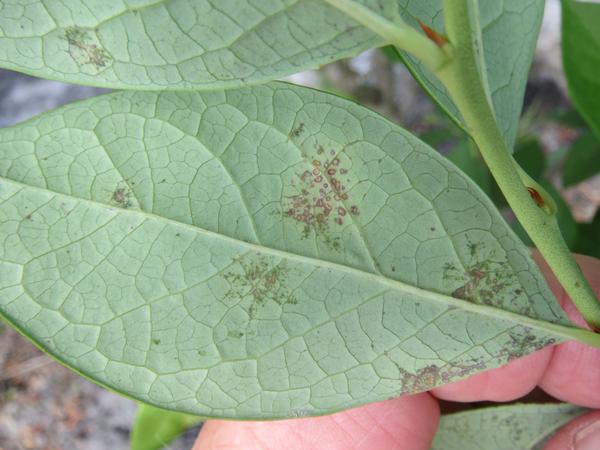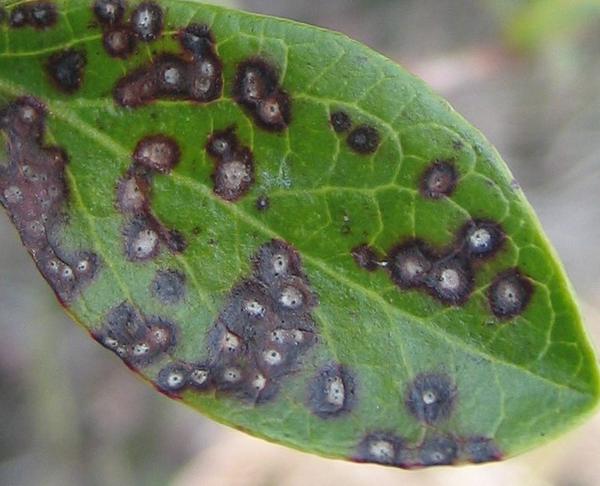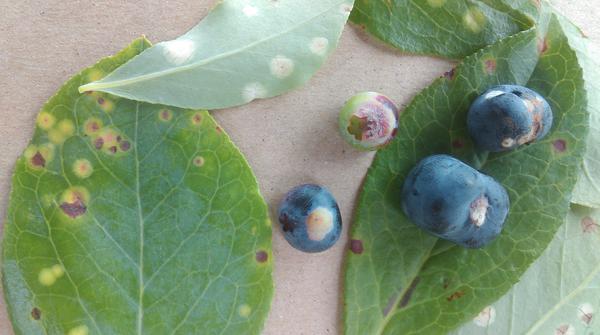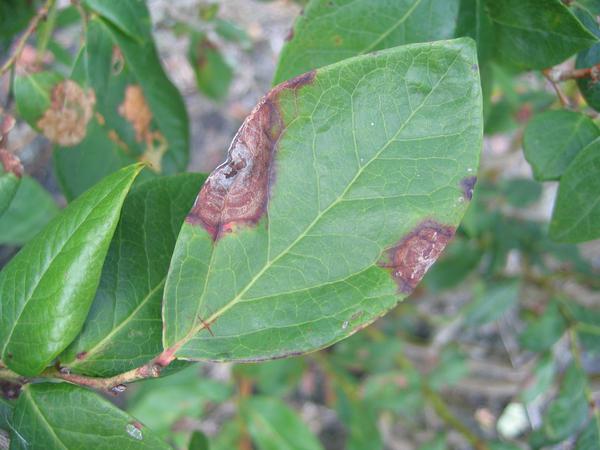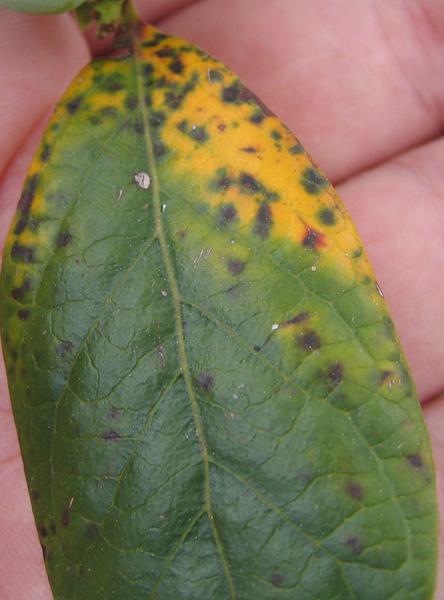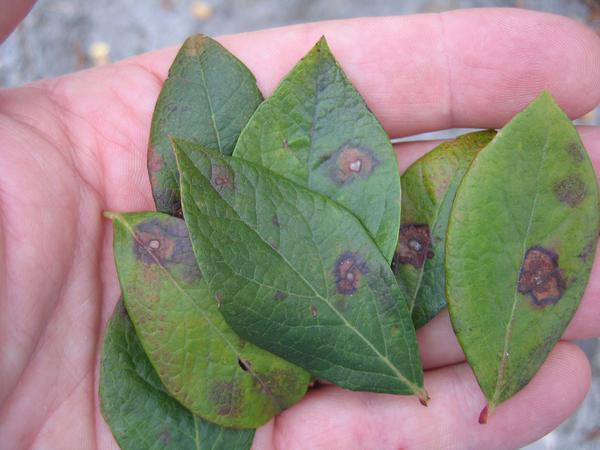General Information
Leaf spot diseases affect blueberry plants by causing early defoliation that weakens the plant and reduces overall vigor. Premature defoliation due to leaf diseases also reduces late-summer flower bud formation, and this can significantly reduce yield the following year. Most leaf spot diseases on blueberry are caused by plant pathogenic fungi. In addition to causing leaf spots, some leaf-infecting pathogens can also infect fruit.
Symptoms and Disease Cycles
Gloeosporium Leaf Spot or Anthracnose (Gloeosporium minus) can produce flecking, leaf anthracnose and stem lesions. Gloeosporium leaf spot was first described as a stem and leaf fleck disease of blueberry. Symptoms first appear as small reddish flecks on young leaves and stems of succulent shoots. Leaf and stem flecks do not develop further. The leaf anthracnose stage produces large (1/2 to over 1 inch across) brown to gray lesions that are the most common symptom observed in the field. Development of lesions results primarily from infection through hydathodes at the margins of the leaf, and to a lesser extent through wounds. Secondary stem lesions can develop from leaf infections by growing through the petiole into the stem, and from bud infections late in the season. Stem lesions first appear on current season's growth as dark red circular to elliptical lesions around leaf scars. As the lesions enlarge, the affected stems turn brown and eventually become gray and die. On highly susceptible cultivars such as Duke, Jersey, and Pender, the disease can result in severe dieback.
Septoria Leaf Spot (Septoria albopunctata) can be seen on most highbush and rabbiteye blueberry cultivars grown in North Carolina. Damage can also occur in hardwood rooting beds, causing defoliation and poor growth. The fungus overwinters in infected leaves on the ground and in stem lesions. Spores are produced in abundance on new lesions throughout the season. Spots on leaves are usually small (1/8 to 1/4 inches across) with a white to tan center and a purple border. Small black fungal fruiting bodies may be visible in the center of lesions. Stem lesions are flat or slightly sunken with a tan to gray center and a reddish brown margin. Stem lesions and leaf spots are most severe on small plants or on the lower parts of large plants.
Double Spot (Dothichiza caroliniana) lesions are initially 1/16 to 1/8 inches in diameter. In late summer, the fungus develops a secondary necrotic area around the original lesion spreading in an irregular to fan-shaped pattern. The dark border surrounding the original lesion persists and the large necrotic area surrounds or is to one side of the original lesion.
Gloeocercospora Leaf Spot (Gloeocercospora inconspicua) is of minor importance as a leafspot disease in North Carolina. It appears on the foliage by mid-summer as small to medium (1/4 to 1/2 inch) dark brown, circular to angular lesions surrounded by a dark border.
Alternaria Leaf Spot (Alternaria tenuissima) occurs primarily in the spring during prolonged periods of cool wet weather, when spores are produced in abundance. In most cases only lower leaves are affected. Because of its importance as a postharvest fruit decay organism, an increase of the fungus on blueberry leaves in May can cause increased postharvest decay of fruit. Leaf symptoms appear as small to medium (1/4 inch) circular to irregular-shaped brown to gray lesions surrounded by a red border. Prolonged periods of high humidity favor disease development.
Powdery Mildew (Microsphaera vaccinii) usually does not develop on blueberry leaves until midsummer after the crop is harvested. The disease first appears as a faint white fungal layer on maturing leaves, causing pale distorted spots with faint necrotic areas, becoming more distorted and red as the season progresses. In late season, white fungal growth on the upper surface of leaves may include small black fungal fruiting bodies (cleistothecia) that are the overwintering stage of the fungus.
Rust (Pucciniastrum vaccinii) is often first noticed as yellowing and defoliation of older leaves. This disease can be diagnosed in the field by the characteristic small, necrotic lesions that produce orange masses of uredospores on the underside of the leaf. The leaf tissue around individual lesions may remain green on the upper leaf surface. In North Carolina blueberry rust overwinters on plant debris and on infected stems and leaves. Rust is most often seen late in the season, but following mild winters can appear on new growth in spring, and can also infect flowers and fruit.
Exobasidium leaf and fruit spot (Exobasidium maculosum) overwinters on the surface of dormant stems and infects new leaves, stems and emerging fruit in early spring. The fungus produces 1/8 to 1/2 inch pale green spots on the upper surface of leaves. The underside of each lesion is covered with a layer of pure white fungal growth. Spots also occur on fruit, and become most noticeable at harvest as a green or sunken pink spot on the berry that does not ripen normally. As Exobasidium leaf spots age, they become necrotic and deteriorate, no longer exhibiting the characteristic signs described above. Exobasidium is one of the few leaf diseases that can be severe enough in home gardens to warrant fungicidal control.
Abiotic leaf disorders (various) can mimic leaf disease. Drought stress and fertilizer burn have a similar appearance, usually appearing as a marginal burn with uniform brown color. Nutritional disorders such as iron chlorosis caused by high soil pH may exhibit interveinal yellowing.
Control
Leafspot diseases are controlled through the use of (i) host plant resistance, (ii) fungicides and (iii) cultural practices to improve plant health. In most cases, homeowners and small pick-your-own operations will not need to use fungicides to control leaf diseases, with the possible exception of delayed dormant sprays in February for Exobasidium leaf and fruit spot.
Resistance – Most currently-available cultivars are resistant to leaf diseases. This includes those currently grown commercially in North Carolina as well as those available for purchase by homeowners at retail outlets. Leaf spot problems are most common in older plantings of susceptible cultivars.
Fungicides for control of blueberry leaf diseases are readily available on a commercial scale but may be difficult to find for homeowners seeking small quantities. Most fungicides act as protectants and must be applied prior to the onset of symptoms. Early season applications are the most effective, and growers in North Carolina are advised to make at least one fungicide application for leafspot control between bloom and harvest. The remaining fungicide applications, if needed, are applied at two-week intervals. The use of crop oils or Neem oil products is not recommended. Oil-based sprays cause an increase in leaf spots by damaging the protective waxes on the leaf surface that normally block fungal penetration.
Winter pruning is a critical annual practice for maintaining bush health and vigor. Without regular pruning, bushes tend to over-produce, resulting in small berries, excessive fruit set, and poor vegetative growth. This overcropping and lack of new growth magnifies the negative effects of leaf diseases.
Postharvest summer mowing (topping) has become a common practice in southeastern North Carolina as a means of maintaining proper bush height and reducing the amount of winter pruning required. An added benefit of this summer pruning technique is the reduction in leaf diseases by removal of older, infected leaves, and subsequent rejuvenation. New midsummer foliage produced after topping persists well into fall without serious leafspot problems. This practice can only be used on early-fruiting cultivars. Later-ripening cultivars will not have enough time to regrow and form new flower buds before cold weather.
Other Links
- Horticulture Information Leaflets (HIL)
- HIL-201 Suggestions for Establishing a Blueberry Planting in Western North Carolina
- HIL-201-B Principles of Pruning the Highbush Blueberry
- HIL-201-E Blueberry Freeze Damage and Protection Measures
- North Carolina Insect Notes
- North Carolina Agricultural Chemicals Manual
- Southern Region Small Fruits Consortium
Publication date: Jan. 3, 2014
Reviewed/Revised: Nov. 14, 2020
Recommendations for the use of agricultural chemicals are included in this publication as a convenience to the reader. The use of brand names and any mention or listing of commercial products or services in this publication does not imply endorsement by NC State University or N.C. A&T State University nor discrimination against similar products or services not mentioned. Individuals who use agricultural chemicals are responsible for ensuring that the intended use complies with current regulations and conforms to the product label. Be sure to obtain current information about usage regulations and examine a current product label before applying any chemical. For assistance, contact your local N.C. Cooperative Extension county center.
N.C. Cooperative Extension prohibits discrimination and harassment regardless of age, color, disability, family and marital status, gender identity, national origin, political beliefs, race, religion, sex (including pregnancy), sexual orientation and veteran status.

